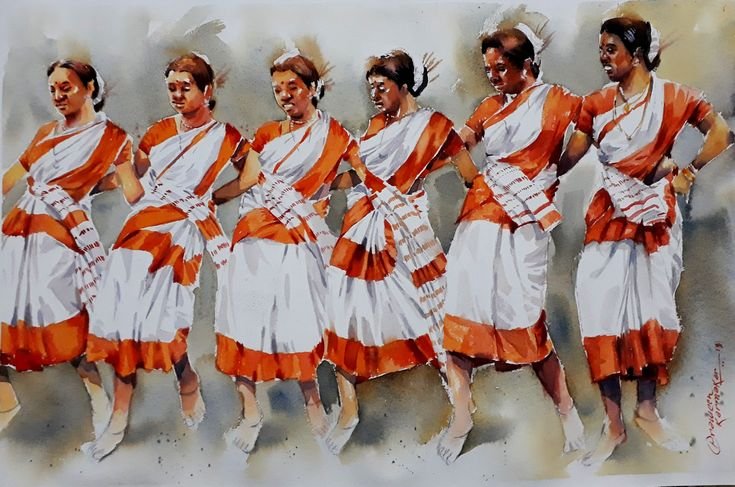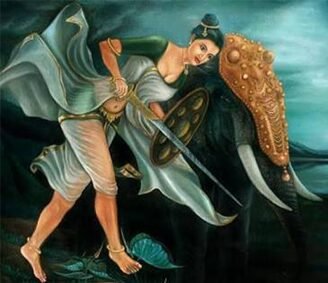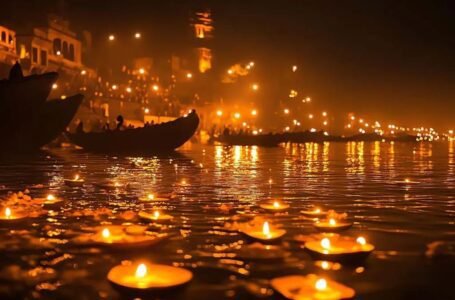Exploring the Rhythmic Soul of Jhumur: A Tribal Folk Song Tradition

Jhumur dance is a tradition of the tribal of Tripura, West Bengal, Odissa, and Jharkhand states of the eastern part of India, which is lively folk music that has no parallel in present day world. Sung and danced at festivals, rituals and other social get-togethers, the Jhumur is not just a form of music and dance but is activism and documentation of tribal’s way of life, their devotion and togetherness. Though, this diverse and colourful tradition is slowly fading away and that is why its importance should be brought to focus, its origins traced and the causes of the decline figured out.
What are Tribal Folk Songs?
Traditional and contemporary tribal folk songs are group songs that are motivated from ethnic societies with the interests of the tribal individuals. Many of these songs are as historical documents, which chronicles the living, suffering, thinking, and dreaming of a people. While Western style is specialized, formal and documented, tribal folk music is informal, impromptu and learned only from stories.
Characteristics of tribal folk songs include:
Simple Melodies: Melodies which are easy to mimic that harmonize with the sounds of nature.
Call-and-Response Patterns: Cultural promotion of exercising, participation, and roving in groups.
Themes of Nature and Spirituality: Praise of topographical features, gods and goddesses, as well as spirits of ancestors.
Use of Indigenous Instruments: The songs are sung with auto-tune and supported by non synthesized dhol, mandar, flute, cymbals etc.
As a tribal folk form, Jhumur has all these characteristic features, and thereby it remains as alive testimony to the existence of the tribes.
Jhumur: The Essence of Tribal Life
Origins and Meaning
It is thought that the term ‘Jhumur’ has been so named due to the rhythmic body movement of the dance and use of anklets during the performance. It is chiefly connected with the Santal, Munda, Oraon, and other tribes of India, living in the eastern part of the peninsula.
Though commonly, Jhumur songs portray the aspects of love, the nature, farming practices, and worship. These songs are performed during Sibili, marriages, and other carnivals or other functions related to tribal gods or goddesses. It is through them that the people can present their solidarity in celebration, mourning or worship.
Category of Jhumur Songs and the Related Dance
Devotional Jhumur
Such songs are sung in the worship of tribal gods and goddesses including, Marang Buru and Jaher Era. They are usually performed during the religious ceremonies and the songs are choreographed as prayers danced.
Love and Romance
Love and separation are assumed as the most prominent themes in the Jhumur songs. These are normally done during functions that entail autorial involvement, where young boys and girls display what may be referred to as dancing courtship.
Agricultural Jhumur
These songs can be sung anytime during sowing period, plowing period or during the period of harvesting. In most of these performances, the dance steps portray an aspect of farming, as if telling a story.
Ritualistic Jhumur
Sung on special occasions like marriage ceremony or burial this dances and songs were considered to be sacred connecting between this world and the other one.
Instruments and Dance
Jhumur performances are incomplete without traditional instruments such as:
Dhol and Mandar: The drums are the instruments that supply the beat in most of the musical categories.
Flute: Adding melodic depth.
-Ghungroo (Anklets): In addition to improving the sound quality with their bells.
The dance following is Circular to signify unity of a continuance / continuity the dancers, wearing tribal costumes and graceful dancing to the rhythm perfecting the show.
The Decline of Jhumur: Why Is It Becoming Rare?
In other words, despite the fact that Jhumur dancing is a worshipper of the distinct Gond cultural values and seemed to be the most vibrant dance form, it is currently lacking the attributes essential for survival in the present day world. Some of the key reasons include:Remaining categories of factors are Urbanization and Modernization Because of this the tribal communities have been forced to move to urban areas to seek for livelihoods hence the break from their culture. Alas, imitative folk dance-forms like the Jhumur are lost when people begin to lead new and more modern lives.
Lack of Documentation
This despite the fact that Jhumur is an oral tradition were songs and plays are performed; they are hardly written down and may fade away as the older generation dies out.
Mainstream Media Network Output
Modern entertainment has however outcompeted traditional arts by relegating the latter to the background.
Economic Pressures
Small tribes often experience the problem of poverty and thus there is no time and materials to devote attention to culture.
Overlook in Policy Making and Scholarship
Although such art forms still exist and even have considerable cultural significance in the specified tribes of India, they are hardly supported by the government bodies or academia.
Reviving Jhumur: The Trailblazers
Some individuals and organizations have taken commendable steps to preserve and promote Jhumur:
Folk Artists and Performers
Santal folk ensemble and other local talents like Malini Murmu have devoted their entire lives avidly performing and teaching the remaining Jhumur.
No government organisation, NGOs and Cultural organizations
Some organizations have staged performances of Jhumur in an attempt at popularizing the dance among the younger people Some examples are the SPIC MACAY (Society for the Promotion of Indian Classical Music and Culture Amongst Youth).
Research and Documentation
Academicians and researchers are developing an appreciation of Dalu’s Jhumur songs and dances so that the younger generation does not lose the tradition all over again.
Integration with Tourism
Cultural tourism in Jharkhand and Odisha have promulgated works portraying Jhumur ,which gave tribal artistes exposure.
Why Jhumur Matters: A Cultural Treasure
A Window into Tribal Life
The film demonstrates tolerance, compassion and cultural awareness, by picturing the existing values, the challenges and joys of the tribal peoples’ lives.
An Identity and Pride
To the tribal, Jhumur becomes the process that defines their cultural self and hence, allows them to fit in.
A Lesson in Sustainability
The flavor of nature and balance in Jhumur songs teaches people about dovetailed life patterns that the contemporary world forgets.
Jhumur: Enriching Cultural Heritage
Jhumur, a tribal folk music tradition deeply rooted in Bengal, Odisha, and Jharkhand, is a vital part of the region’s cultural fabric. Characterized by soulful melodies, rhythmic beats, and heartfelt lyrics, Jhumur reflects the lives, emotions, and experiences of indigenous communities. These songs, often accompanied by traditional dances, are performed during festivals, harvest celebrations, and rituals, symbolizing unity, joy, and spiritual connection.
Jhumur stands as a testament to the region’s rich cultural diversity and oral traditions, passed down through generations. The themes of Jhumur songs often revolve around love, nature, and social life, offering a glimpse into tribal philosophy and values. The accompanying dance, performed in vibrant attire and synchronized movements, amplifies the art form’s visual and emotional appeal.
However, the encroachment of modernity and diminishing tribal populations have rendered Jhumur increasingly rare. Efforts to revive and sustain this heritage are essential to preserving its cultural significance. Documentation, workshops, and performances in urban spaces can help raise awareness and appreciation.
By celebrating Jhumur, we honor not just the art form but also the communities that have kept it alive, ensuring it continues to enrich the cultural mosaic of India for future generations.
Jhumur: A Living Heritage of Eastern India
Jhumur, a traditional tribal folk music and dance form, holds a significant place in the cultural heritage of Bengal, Odisha, and Jharkhand. Rooted in the traditions of indigenous communities, it is performed during festivals, harvest celebrations, and rituals, reflecting the intimate connection between tribal life and nature. The songs of Jhumur often narrate stories of love, longing, daily life, and spirituality, infused with a profound respect for the environment and community values. Accompanied by rhythmic drumming and vibrant dances, Jhumur becomes a powerful expression of collective identity and celebration.
What makes Jhumur particularly important is its role in preserving oral traditions and indigenous knowledge. Through its melodies and lyrics, it serves as a living archive of tribal history, philosophy, and customs. The dance component, performed with precise, fluid movements and colorful attire, enhances its visual and cultural richness, making it a captivating art form.
However, the decline of tribal populations, migration, and the influence of modern entertainment pose significant threats to Jhumur’s survival. To protect this invaluable heritage, initiatives such as documentation, promotion in cultural festivals, and integration into educational curricula are crucial. Reviving Jhumur not only safeguards an art form but also strengthens the cultural identity of the communities it represents.
Conclusion: A Call to Action
So when one talks of Jhumur, it is much more than a music and dance, it is the living pulse of tribals of east India. Its harmonies and beat contains the elderly people’s teachings to remind us about a more harmonious civilized society. Nonetheless, the modernizing and neglect forces are highly likely to silence this cultural icon.The tradition of Jhumur cannot and should not be preserved by a single individual on his or her own. The society, including the Governments, the cultural agencies and the regional people and artists shall continue to offer the platforms, to document and support the pedagogy of Jhumur tradition in educational institutions. In doing so, not only do we preserve a valuable asset of the American cultural history but also give the courage and knowledge of the tribal cultures still alive in today’s society.


